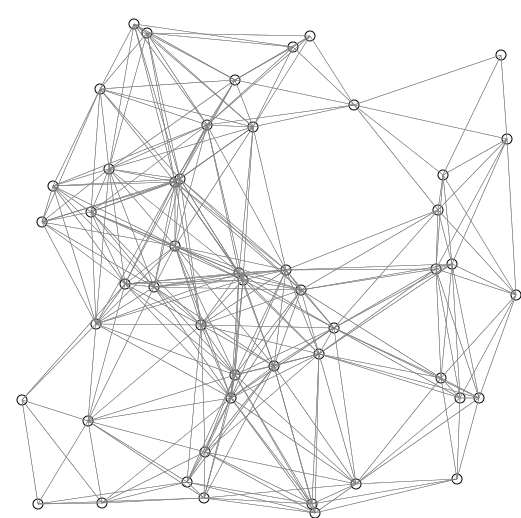This repos contains an implementation of dijkstra's algorithm that can be used with any data structure.
Dijkstra's algorithm is a variant of the BFS algorithm that finds the shortest path between two nodes in a graph.
I discovered the Dijkstra's algorithm when I was working on advent-of-code 2021 day 15. Each example of the algorithm implementation was very specific to the data structure of the current use case, so I tried to write a generic and flexible implementation with the help of Paul Brauner.
Dijkstra's function can accept different data structure as input: (example of inputs used in unit tests)
- On this 2D matrix (from advent-of-code example), each vertex is a vec2 coordinate
(y, x)when the cost of the path is number of the cooridnate.
const matrix = [
[1, 1, 6, 3, 7, 5, 1, 7, 4, 2],
[1, 3, 8, 1, 3, 7, 3, 6, 7, 2],
[2, 1, 3, 6, 5, 1, 1, 3, 2, 8],
[3, 6, 9, 4, 9, 3, 1, 5, 6, 9],
[7, 4, 6, 3, 4, 1, 7, 1, 1, 1],
[1, 3, 1, 9, 1, 2, 8, 1, 3, 7],
[1, 3, 5, 9, 9, 1, 2, 4, 2, 1],
[3, 1, 2, 5, 4, 2, 1, 6, 3, 9],
[1, 2, 9, 3, 1, 3, 8, 5, 2, 1],
[2, 3, 1, 1, 9, 4, 4, 5, 8, 1],
]- This graph can be used too when object keys are verticies and values are neighbors associated to there own cost.
const graph = {
start: { A: 5, B: 2 },
A: { start: 1, C: 4, D: 2 },
B: { A: 8, D: 7 },
C: { D: 6, finish: 3 },
D: { finish: 1 },
finish: {},
}In order to accept different data structures, dijkstra recieves some functions as params:
getNeighbors: (v: GVertex) => GVertex[]returns array of vertices that are neighbors ofvgetCostBetweenVertices: (a: GVertex, b: GVertex) => numberreturns cost of edge between thwo verticessource: GVertexvertex from which algorithm startsisTarget: (vertex: GVertex) => booleanreturnstrueif vertex is the targetqueue = priorityQueueMinHeap<GVertex>()queue that is used to store vertices in order of their distance from source
exemple of usage:
const getNeighbors = (vertex) => Object.keys(graph[vertex])
const distanceBetweenTwoVertices = (v1, v2) => graph[v1][v2]
const isTarget = (vertex) => vertex === "finish"
const shortestPathCost: number = dijkstra<string>(
getNeighbors,
distanceBetweenTwoVertices,
"start",
isTarget
)dijkstra returns the shortest path cost from source to target
This algorithm is using a priority queue to store vertices in order of their distance from source. The last one is a big part of Dijkstra implementation if we want to use it with big data structures.
Two types of priority queue have been tested in this algorithm:
- priority Queue min (
O(n)complexity) - priority Queue min with binary heap (
O(log n)complexity)
The second one will be more efficient because binary heap doesn't require us to iterate over the list.
- node js
>= 16 - npm
>= 8
- Clone the repos
$ git clone git@github.com:willybrauner/dijkstra-algorithm.git- Install dépendencies
$ npm i- Start tests once
$ npm run test- Start tests in watch mode
$ npm run test:watch© Willy Brauner & Paul Brauner
